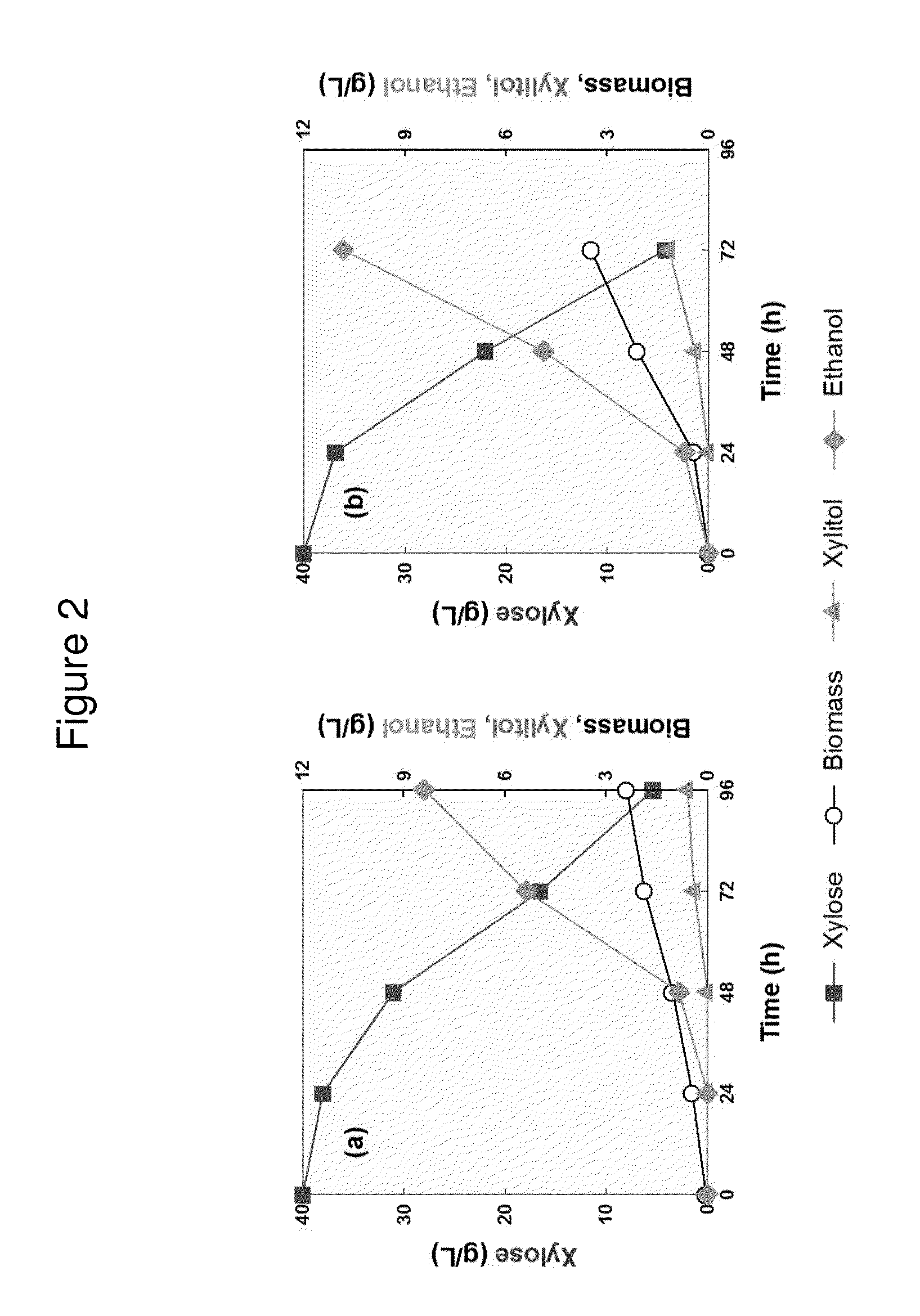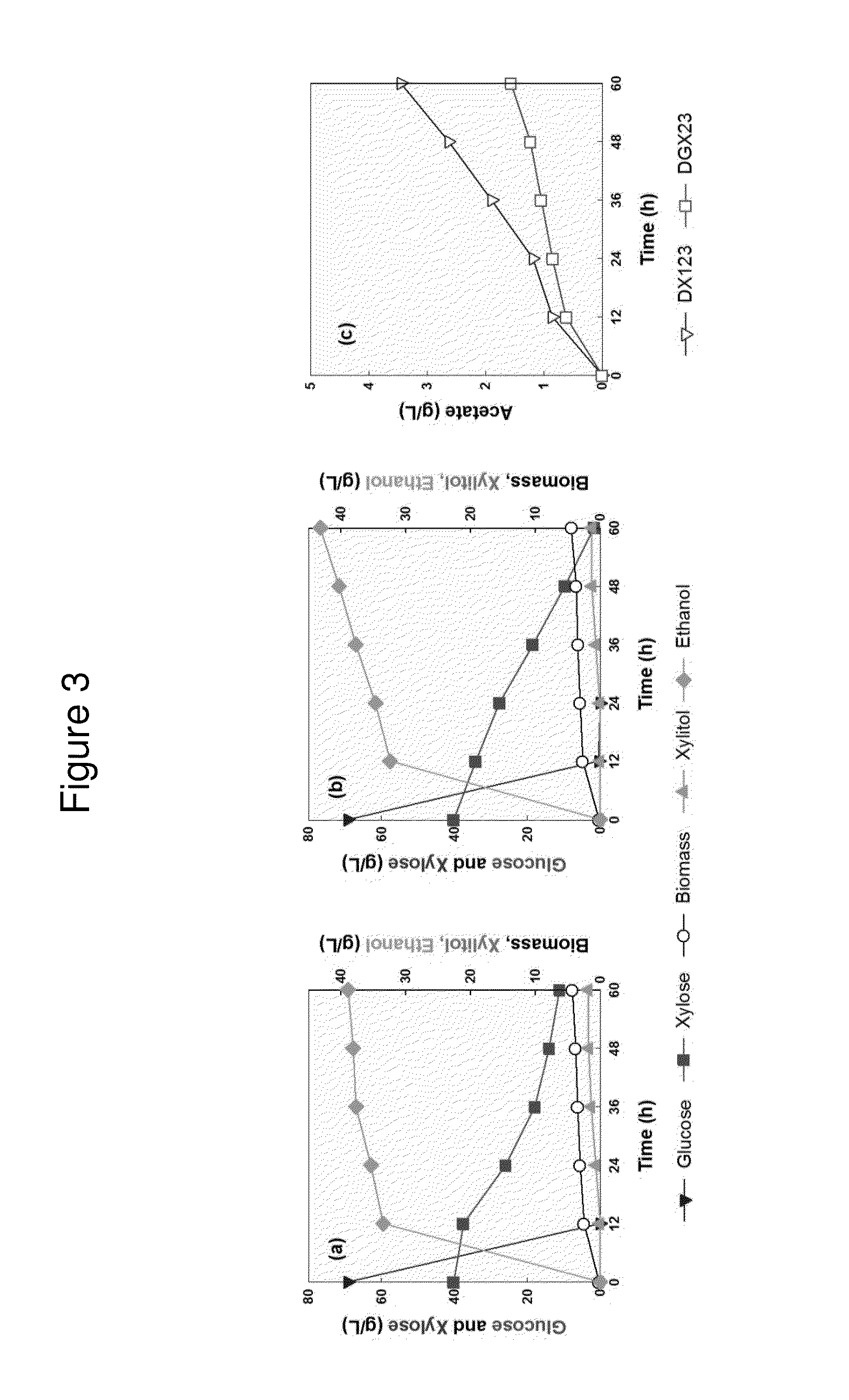Xylose-fermenting microorganism
a technology of xylose and microorganisms, which is applied in the field of fermentation of xylose, can solve the problems of reducing the consumption rate of xylose, unable to ferment, and cellular redox imbalance, so as to increase the growth rate of cells, increase the consumption of xylose, and increase the production of ethanol
- Summary
- Abstract
- Description
- Claims
- Application Information
AI Technical Summary
Benefits of technology
Problems solved by technology
Method used
Image
Examples
example 1
Xylose Metabolism by an Engineered S. cerevisiae without Introducing Xylose Reductase from Scheffersomyces stipitis (Pichia stipitis)
[0205]In order to determine if S. cerevisiae can assimilate xylose without introducing XYL1 from S. stipitis into S. cerevisiae, an expression cassette containing only XYL2 and XYL3 from S. stipitis was integrated into S. cerevisiae strain D452-2, and the resulting transformant was named DX23. We tested if the engineered strain (DX23) would metabolize xylose as a sole carbon source. With high cell density inoculation (optical density (OD) 30), the DX23 strain was able to consume xylose very slowly (about 30 g / l of xylose was consumed in 6 days). Interestingly, the DX23 strain did not accumulate xylitol at all. Only cell growth and ethanol production (3 g / L) were observed. This result indicates that the S. cerevisiae strain DX23, which does not contain XYL1 from S. stipitis, can ferment xylose using endogenous enzymes in S. cerevisiae for converting xyl...
example 2
Construction of an Engineered S. cerevisiae Strain Over-Expressing ScGRE3
[0206]We selected GRE3 from S. cerevisiae as a putative xylose reductase enabling xylose fermentation with overexpression of SsXYL2 and SsXYL3, and over-expressed it in S. cerevisiae. Two almost identical expression cassettes containing either SsXYL1 or ScGRE3 with SsXYL2 and SsXYL3 were integrated into S. cerevisiae strain D452-2. The resulting transformants were named as DX123 (SsXYL1, SsXYL2, and SsXYL3) and DGX23 (ScGRE3, SsXYL2, and SsXYL3). Both engineered strains showed similar levels of xylitol dehydrogenase activity (Table 1). A big difference was that in vitro XR activity of DGX23 was observed only when NADPH was added as a cofactor, while in vitro XR activity of DX123 was observed using both NADPH and NADH as cofactors. The NADPH-dependency of ScGRE3 XR activity is consistent with a previous report that determined XR activities and cofactor dependencies of ScGRE3 and SsXYL1 after ScGRE3 or SsXYL1 ove...
example 3
Xylose Fermentation by Engineered S. cerevisiae Over-Expressing ScGRE3
[0209]We compared xylose fermentation phenotypes of engineered S. cerevisiae strains expressing either ScGRE3 aldose reductase or SsXYL1 xylose reductase along with SsXYL2 XDH and SsXYL3 XK using 40 g / L of xylose as a sole carbon source. Both the engineered strains were able to ferment xylose and produce ethanol with decent yields when they were inoculated around OD=1 (FIG. 1). Interestingly, the ScGRE3 AR overexpressing-strain (DGX23) was able to ferment 40 g / L of xylose completely earlier (within 72 vs. 96 hours), with higher ethanol yield (0.30 vs. 0.24 g ethanol / g xylose), than the SsXYL1 XR-overexpressing strain (DX123). Cell growth of the DGX23 strain was also faster than DX123 (FIG. 2).
[0210]We also examined fermentation characteristics of the both strains in a mixture of glucose and xylose. The amounts of glucose (70 g / L) and xylose (40 g / L) reflected average composition of cellulose and hemicelluose in li...
PUM
| Property | Measurement | Unit |
|---|---|---|
| pH | aaaaa | aaaaa |
| pH | aaaaa | aaaaa |
| Tm | aaaaa | aaaaa |
Abstract
Description
Claims
Application Information
 Login to View More
Login to View More - R&D
- Intellectual Property
- Life Sciences
- Materials
- Tech Scout
- Unparalleled Data Quality
- Higher Quality Content
- 60% Fewer Hallucinations
Browse by: Latest US Patents, China's latest patents, Technical Efficacy Thesaurus, Application Domain, Technology Topic, Popular Technical Reports.
© 2025 PatSnap. All rights reserved.Legal|Privacy policy|Modern Slavery Act Transparency Statement|Sitemap|About US| Contact US: help@patsnap.com



